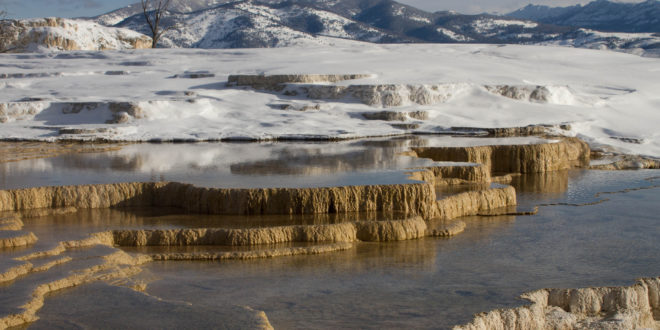The calendar says April, but it ain’t exactly what most of us consider “spring” around the Greater Yellowstone Ecosystem.
Sure, we’ve seen a few robins, bluebirds and sandhill cranes. But the temperatures are sticking to a pretty consistent low-to-mid 40s for the daytime high, and in the mid-20s for the overnight lows.
And it keeps on snowing. Livingston, Montana, 50 miles to the north of the park’s North Entrance, got a total of not quite 10 inches of new snow between Saturday and Monday. The local kids were bundled up in boots and parkas for the town’s annual Easter Egg hunt Sunday.
Park officials announced last week the start of spring biking (at 40 degrees? Yeah, right.) Spring biking is an annual thing where the roads are plowed but still not open to car travel. Bicyclists may enter the park at the north or west entrance and bike at their own risk—there are no services open and there’s a chance of meeting bison on the road. And why not? Bison aren’t dumb. After a long, hard winter, they’d rather walk on a plowed road than drag themselves through deep snow just like anybody would.
As part of Yellowstone’s rolling road openings, some of the roads are scheduled to open to vehicle travel on Friday, April 20. The roads will open from the North Entrance at Gardiner to Old Faithful and West Yellowstone and Norris to Canyon. A park spokeswoman said Monday the snowplowing to get those roads open is on schedule, and it’s too soon to say whether the winter’s heavy snowfall could delay the April 20 opening.
The rest of the road-opening schedule, according to the National Park Service, looks like this:
May 4: East Entrance to Lake over Sylvan Pass, Canyon Junction to Lake.
May 11: South Entrance to West Thumb, Lake to West Thumb, West Thumb to Old Faithful over Craig Pass, Tower Junction to Tower Fall.
May 25: Tower Fall to Canyon Junction over Dunraven Pass; and the Beartooth Highway, which connects Cooke City, Montana to Red Lodge.
The Natural Resources Conservation Service, a branch of the U.S. Department of Agriculture, measures the snow around the region throughout the season. The NRCS issues a monthly report from fall to spring every year assessing the mountain snowpack across the West. The Bozeman office issues a Montana-wide report, which includes the park in the Upper Yellowstone portion of the report. The report lists the amount of snow and the snow-water equivalent at hundreds of SNOTEL sites in various drainages statewide.
SNOTEL stands for “Snowpack Telemetry,” which is a backcountry weather station that measures snow and transmits the data wirelessly in real time.
For March 1, the fellows who write the report coined a new word to describe the previous month’s snowfall and accumulation—“Febru-buried!”
Some SNOTEL sites around Yellowstone broke all previous records and many others were the second-highest on record.
Snowpack in the mountains is well above normal, averaging 164 percent of normal for the period from 1981 to 2000.
All that snow is the result of precipitation has been higher than average—141 percent of normal in the mountains and 173 percent in the valleys. These numbers were issued in the first week of March. The April update—reporting on March—is due out by the end of the week.
All this snow means there should be plenty of the water in the region’s rivers for agriculture, recreation and wildlife. But if the later spring warms up too quickly, all that water stored in the mountains can melt and cause flooding downstream. An early runoff also means a shorter whitewater rafting season for the commercial guides who make a living on the river, and it can mean poor fishing into July.
Billings-based meteorologist for the National Weather Service Todd Chambers said Monday the cold and snowy weather is caused by a wet Pacific Northwest storm meeting up with cold Canadian air from the north. He said it would likely stay cool and that another storm system was predicted for the end of the week.
If you’re planning an early-season visit to beat the high-summer crowds, be prepared for snow at higher elevations, pack lots of clothing layers for all weather possibilities and combinations (can happen in a single day!), and check on local conditions before you travel.
 Yellowstone Insider Your Complete Guide to America's First National Park
Yellowstone Insider Your Complete Guide to America's First National Park





